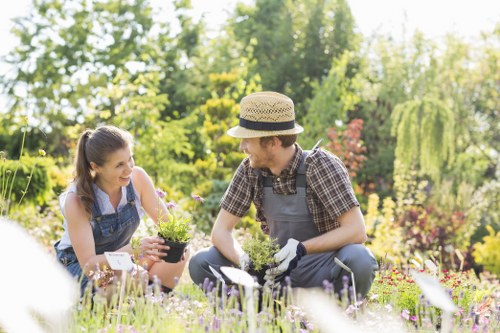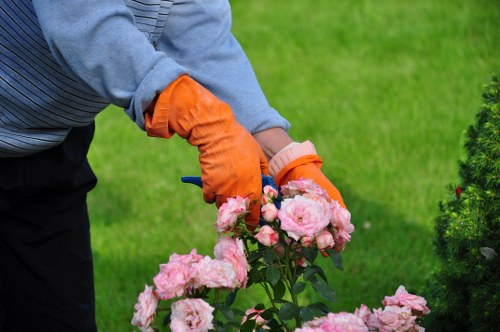Ultimate Guide to Garden Maintenance in Northolt
Introduction to Garden Maintenance

Maintaining a beautiful garden in Northolt requires dedication, knowledge, and the right techniques. Whether you're a seasoned gardener or just starting out, understanding the essentials of garden maintenance can transform your outdoor space into a lush, vibrant haven.
Regular upkeep not only enhances the aesthetic appeal of your garden but also ensures the health and longevity of your plants. From soil preparation to pest control, each aspect plays a crucial role in creating a thriving garden.
In this guide, we'll explore the key elements of garden maintenance in Northolt, providing you with practical tips and expert advice to keep your garden in top shape all year round.
Seasonal Garden Maintenance

Spring Maintenance
Spring is the perfect time to rejuvenate your garden after the winter months. Start by cleaning up any debris, pruning dead branches, and preparing the soil for new growth.
Planting seasonal flowers and vegetables can give your garden a colorful and productive start to the year. Don't forget to mulch your beds to retain moisture and suppress weeds.
Regular watering is essential as temperatures begin to rise. Consider installing an irrigation system to ensure your plants receive consistent hydration.
- Prune deciduous trees and shrubs
- Apply mulch to garden beds
- Plant spring-flowering bulbs
Summer Garden Care

Managing Growth
During summer, your garden will experience rapid growth. It's important to monitor your plants for signs of stress and provide adequate water.
Regularly fertilize your plants to support their development. Choose a fertilizer that matches the specific needs of your garden.
Pest control becomes a priority as insects and other pests seek out your plants. Use eco-friendly solutions to manage infestations without harming beneficial insects.
- Ensure consistent watering
- Fertilize plants appropriately
- Implement organic pest control methods
Autumn Garden Preparation

Preparing for Winter
Autumn is a time to prepare your garden for the colder months. Start by removing spent plants and adding compost to enrich the soil.
Protect sensitive plants by covering them or moving them indoors. This helps prevent frost damage and ensures they survive the winter.
Prune trees and shrubs to remove any damaged branches and to shape them for healthier growth in the spring.
Key Tasks for Autumn
- Clean up garden beds
- Apply compost and mulch
- Prune and protect plants
Winter Garden Maintenance

Keeping Your Garden Healthy
Even in winter, your garden requires attention. Protect plants from harsh weather by using covers and ensuring proper drainage to prevent waterlogging.
Take this time to plan for the upcoming gardening season. Research new plant varieties and design ideas to incorporate into your garden.
Maintain your tools by cleaning and storing them properly. This prolongs their lifespan and ensures they're ready for use when gardening resumes.
- Protect plants with covers
- Plan for next gardening season
- Maintain and store garden tools
Essential Garden Maintenance Tasks

Weeding and Mulching
Weeding is a fundamental aspect of garden maintenance. Regularly removing unwanted plants prevents them from competing with your desired plants for nutrients and water.
Mulching not only suppresses weeds but also helps retain soil moisture and regulate temperature. Organic mulches, such as bark or straw, add nutrients to the soil as they decompose.
Consider using landscape fabric as an additional barrier against weeds, especially in high-traffic areas of your garden.
Pruning and Trimming
Enhancing Plant Health
Pruning and trimming are essential for maintaining the shape and health of your plants. Remove dead or diseased branches to prevent the spread of pests and diseases.
Regular trimming encourages new growth and can increase the flowering and fruiting potential of your plants.
Use sharp, clean tools to make precise cuts, ensuring the best possible recovery and reducing the risk of damage.
- Prune in the appropriate season
- Remove dead or diseased wood
- Shape plants for optimal growth
Soil Care and Fertilization
Building Healthy Soil
Healthy soil is the foundation of a thriving garden. Test your soil's pH and nutrient levels to determine what amendments are needed.
Incorporate organic matter, such as compost or well-rotted manure, to improve soil structure and fertility.
Implement crop rotation and cover cropping techniques to maintain soil health and reduce the risk of pest and disease buildup.
- Test and amend soil as needed
- Incorporate organic matter regularly
- Practice crop rotation and cover cropping
Irrigation and Water Management
Efficient Watering Techniques
Proper irrigation is crucial for plant health. Water your garden early in the morning or late in the evening to minimize evaporation and ensure deep soil penetration.
Consider installing a drip irrigation system to deliver water directly to the plant roots, reducing waste and promoting efficient usage.
Regularly check for leaks or blockages in your irrigation system to maintain optimal performance and prevent water wastage.
- Water during cooler parts of the day
- Use drip irrigation systems
- Maintain and inspect irrigation equipment
Pest and Disease Management
Protecting Your Garden
Effective pest and disease management is key to a healthy garden. Monitor your plants regularly for signs of trouble and take prompt action if issues arise.
Use integrated pest management (IPM) techniques, combining biological, cultural, and mechanical methods to control pests sustainably.
Avoid overusing chemical pesticides, opting instead for natural alternatives that are safer for beneficial insects and the environment.
- Regularly inspect plants for pests
- Implement IPM strategies
- Use natural pest control methods
Garden Tool Maintenance
Keeping Your Tools in Top Shape
Well-maintained garden tools are essential for efficient and effective garden maintenance. Clean your tools after each use to prevent rust and corrosion.
Sharpen blades regularly to ensure clean cuts, which promote healthier plant growth and reduce damage.
Store your tools in a dry, secure place to extend their lifespan and maintain their functionality.
- Clean tools after each use
- Sharpen blades regularly
- Store tools properly
Lawn Care in Northolt
Maintaining a Lush Lawn
A well-maintained lawn adds beauty and value to your property. Regular mowing, watering, and fertilizing are essential for a healthy, green lawn.
Control weeds and manage pests to prevent them from damaging your grass. Aerate your lawn annually to improve soil health and promote vigorous growth.
Consider overseeding bare patches to maintain an even, dense turf that can withstand foot traffic and weather variations.
- Mow regularly at the correct height
- Water deeply and infrequently
- Aerate and overseed annually
Hardscaping and Garden Structures
Enhancing Your Garden's Functionality
Incorporate hardscaping elements such as pathways, patios, and garden beds to add structure and functionality to your garden.
Choose materials that complement your garden's style and ensure durability against Northolt's climate conditions.
Proper installation and regular maintenance of these features will enhance both the aesthetic appeal and practicality of your outdoor space.
- Design functional pathways and patios
- Select durable, weather-resistant materials
- Maintain and repair structures as needed
Choosing the Right Plants for Northolt Gardens
Plant Selection Tips
Choosing the right plants is crucial for a successful garden. Select species that are well-suited to Northolt's climate, soil, and sunlight conditions.
Consider native plants as they are adapted to the local environment and often require less maintenance and water.
Diversify your plant selection to create a resilient garden that can withstand pests, diseases, and varying weather patterns.
- Opt for native and climate-resistant plants
- Diversify plant species for resilience
- Match plants to garden conditions
Eco-Friendly Garden Practices
Sustainable Gardening in Northolt
Adopting eco-friendly gardening practices benefits both your garden and the environment. Use organic fertilizers and pest control methods to minimize chemical usage.
Implement rainwater harvesting systems to conserve water and reduce your reliance on municipal supplies.
Compost kitchen and garden waste to create nutrient-rich soil amendments and reduce landfill contributions.
- Use organic fertilizers and pest controls
- Implement rainwater harvesting
- Compost garden and kitchen waste
Year-Round Garden Maintenance
Consistent Care for Lasting Beauty
Consistent, year-round maintenance is key to sustaining a beautiful garden in Northolt. Develop a maintenance schedule that addresses seasonal needs and ensures continuous care.
Regularly assess your garden's health, making adjustments to your maintenance routine as necessary to accommodate changing conditions.
Stay informed about best practices and emerging trends in gardening to keep your garden thriving and up-to-date.
- Create a seasonal maintenance calendar
- Monitor and adjust care routines regularly
- Stay informed and adapt to new gardening practices
Conclusion
Achieving a Beautiful Garden in Northolt
Effective garden maintenance in Northolt involves a combination of regular care, proper planning, and sustainable practices. By following the tips and strategies outlined in this guide, you can cultivate a garden that is not only beautiful but also resilient and healthy.
Remember, the key to a thriving garden is consistency and a willingness to adapt to the changing seasons and conditions. With dedication and the right approach, your Northolt garden will flourish year after year.
Contact us today to learn more about how we can help you achieve the garden of your dreams!